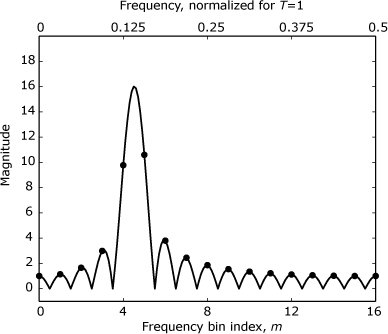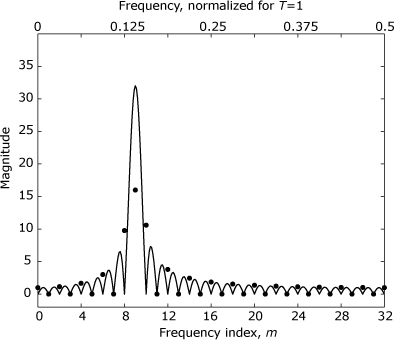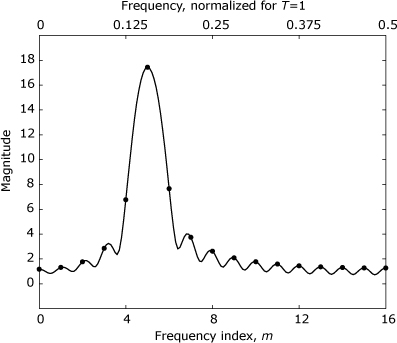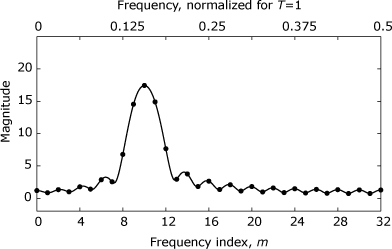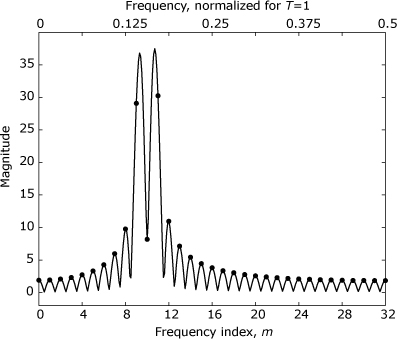Note 16. Exploring DFT Resolution
This note provides demonstrations of a technique called zero padding, which is often used to obtain a finer frequency-domain increment when using a discrete Fourier transform (DFT). These demonstrations show that although zero padding improves the observability of some frequency domain features, it does not improve the frequency resolution of a DFT.
Sometimes important features of a signal’s spectrum fall at frequencies between the DFT bin frequencies, making potentially important features of a signal’s spectrum difficult to detect or observe. This inability to see critical details that fall at frequencies that are not integer multiples of F = NT – 1 is sometimes called the picket fence effect because it is similar to trying to view the details of a scene while looking through a picket fence—some details are clearly visible, while others are hidden by the slats of the fence. The picket fence effect can be mitigated to some extent by reducing the size of the frequency increment, F, but the effect can never be completely eliminated as long as we continue to operate in the discrete frequency domain.
In a DFT, the relationship FNT = 1 always holds. Therefore, the only way that F can be reduced is by increasing T or N. In the design of most signal processing strategies, there is usually not much “wiggle room” when it comes to increasing the value of T. Any viable approach for reducing F must therefore involve increasing N.
16.1. Zero Padding
A classic approach used for decreasing F is called zero padding. This technique involves padding the original N-point input sequence with p zero-valued samples to create an input sequence of length L = N + p. The straightforward approach is to simply extend the DFT to some longer length, L, and collect this new larger number of input samples before computing the L-length DFT.
Zero padding does improve observability of some spectrum features, but contrary to claims often made in the DSP literature, zero padding does not improve frequency resolution in the frequency domain.
Figure 16.3. Fourier spectra from Example 16.1. The spectra are for a rectangularly windowed segment of a sinusoid having a frequency of fc = 4.5F. The dots indicate the magnitudes produced by a 64-point DFT of a 32-sample signal segment that has been padded with 32 zero-valued samples. The solid trace represents the magnitude of the DTFT for a 32-point segment of the original sinusoid.
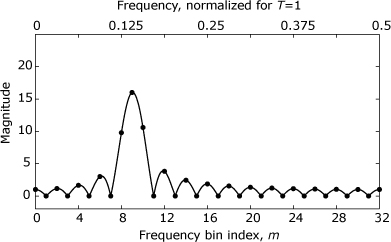
As already stated, the zero padding technique involves extending the original N-point input sequence by appending p zero-valued samples to create an input sequence of length L = N + p. An L-point DFT is then computed instead of an N-point DFT. The frequency domain values then fall at integer multiples of F′ = (LT)–1 rather than at multiples of F = (NT)–1. Because L > N, the new frequency increment of F′ is finer than the original increment of F, thereby improving observability, as demonstrated in Example 16.1.
Because zero padding is able to provide improved observability in the discrete-frequency domain, some texts incorrectly claim that zero padding increases the resolution of the DFT. Resolution is the ability to distinguish two closely spaced features in a signal’s spectrum. As shown in Example 16.2, zero padding does not improve the DFT’s resolution.
16.2. Lengthening the DFT
The straightforward approach to improving both observability and resolution in the DFT result is simply to extend the DFT to some longer length, L, and collect this new, larger number of input samples before computing the DFT. Example 16.3 applies this approach to the two-tone signal from Example 16.2.

